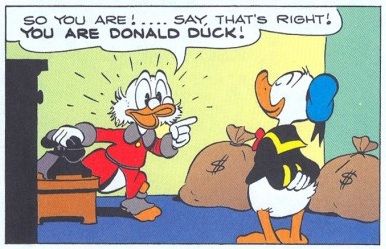When I heard that Rich Tommaso was re-coloring the complete Carl Barks comics for Fantagraphics' archive editions, I was curious about how that would work and how it would affect Tommaso's own work: He shared an Eisner award with Jim Sturm for Satchel Paige: Striking Out Jim Crow, and he has a rich selection of other comics on his website. Although he was just back from Angouleme, Rich was kind enough to answer some questions about his process and how it is changing his own art style.
Brigid: How did you get this gig?
Rich: For years I had been doing some freelance work in the way of lettering (for foreign books translated into English) and spot illustration for Fantagraphics Books and then, last summer, totally out-of-the-blue, Gary emails me asking if I'd like to try-out for a "secret" coloring gig. About a few weeks later, they sent me about ten pages of Donald Duck comics for me to test out coloring—finally breaking the surprise of what the secret was. Based on my ability to capture—as closely as possible—the look of the original, hand-separated colors on the computer, I got the job.
Brigid: Why did Fantagraphics think it was necessary to re-color the Carl Barks comics?
Rich: In the recent past, publishers who've licensed this particular property have done a bad job at recoloring it—using too many modern coloring effects like gradients, highlights, lens flares and inappropriate color schemes to boot. Fanta's aim is to create a new Barks library that maintains a consistency with the old comics from the 40's-60's color schemes.
Brigid: Did Barks do his own coloring, or was there a separate colorist on these?
Rich: He provided colorists with hand-colored mock-ups to follow, I believe.
Brigid: What process do you go through‹how do you choose your palette, and how do
you do the actual coloring?
Rich: I try to keep a sharp eye on the original page scans that Fanta sends along with the higher res B & W tifs. What I try to do besides just matching them, is to mute the colors once I feel that I've honed in on the right one—for example: I find something that is a brown, let's say, made up of a color mixture that is C20, M60, Y80. What I'll do is maybe tone that mixture down to C20, M45, Y65, or something like that. This helps it to look a little closer to what a shade of color might have appeared like in a dot screen form, not as a flat, solid, 400 dot per inch color, which is what you end up getting with computer color printing.
Brigid: What sort of technical or artistic challenges does this present?
Rich: Well, I've hardly done anything of my own in 4-color! Just a couple of times, but it makes me feel as though I could easily handle doing something like that--what with all of the troubleshooting I've already dealt with—AND, I should say, Fanta's helped me with as well. Just little things like creating actions to make set-up on each page much quicker at the start of my day. This job has also made me learn to DRAW with color—as opposed to just lassoing each area and dumping color into that field with the paint bucket. At times I've had to actually draw shapes where the artwork is broken (OR, where there isn't any line work at all—Barks drew with a very relaxed gesture, so a lot of the line work is broken, so not every figure has a closed outline around it) and so, this makes me have to draw the rest of a specific object with the pencil or brush tool myself.
Brigid: How does your finished work differ from the originals?
Rich: Well, I don't use a dot screen, so for instances where there's just an open field of color with no black line art to trap it, I'm using a dry brush tool to make it appear as though there is a dot screen of color lying in said field. Other than that, I'd say my re-colorings are pretty spot-on to the originals.
Brigid:Has working on these affected your own work‹drawing, inking, or writing‹in
any way?
Rich: Looking at anyone's art—who I really enjoy—is bound to have an effect on my own drawing, inking. So yes, I'd say I've been seeing more relaxed, open-line drawings in my own comics here and there, lately.
Also, It's made me a much more efficient colorist, that's for sure.

